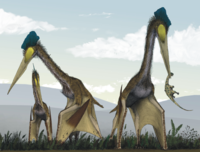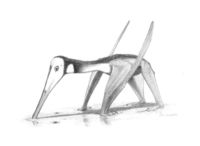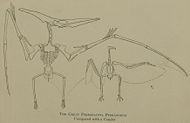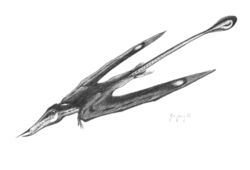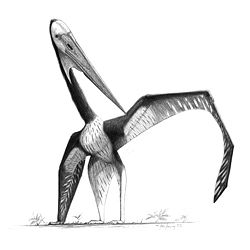Pterosaur
2008/9 Schools Wikipedia Selection. Related subjects: Dinosaurs
| Pterosaurs Fossil range: Late Triassic - Late Cretaceous |
||||||||||
|---|---|---|---|---|---|---|---|---|---|---|
 Coloborhynchus piscator, a pterodactyloid.
|
||||||||||
| Scientific classification | ||||||||||
|
||||||||||
| Suborders | ||||||||||
|
† Pterodactyloidea |
Pterosaurs (pronounced /ˈtɛrəsɔr/, from the Greek πτερόσαυρος, pterosauros, meaning "winged lizard", often referred to as pterodactyls, from the Greek πτεροδάκτυλος, pterodaktulos, meaning "winged finger" /ˌtɛrəˈdæktɨl/) were flying reptiles of the clade or order Pterosauria. They existed from the late Triassic to the end of the Cretaceous Period (228 to 65 million years ago). Pterosaurs were the first vertebrates to evolve powered flight. Their wings were formed by a membrane of skin, muscle, and other tissues stretching from the thorax to a dramatically lengthened fourth finger. Earlier species had long, fully-toothed jaws and long tails, while later forms had a highly reduced tail, and some lacked teeth. Pterosaurs spanned a wide range of adult sizes, from the very small Nemicolopterus to the largest known flying creatures of all time, including Quetzalcoatlus and Hatzegopteryx.
Pterosaurs are sometimes referred to in the popular media as dinosaurs, but this is incorrect. The term "dinosaur" is properly restricted to a certain group of terrestrial reptiles with a unique upright stance (superorder Dinosauria), and therefore excludes the pterosaurs, as well as the various groups of extinct aquatic reptiles, such as ichthyosaurs, plesiosaurs, and mosasaurs.
History of discovery
The first pterosaur fossil was described by the Italian naturalist Cosimo Collini in 1784. Collini misinterpreted his specimen as a sea-going creature that used its long front limbs as paddles. A few scientists continued to support the aquatic interpretation even until 1830, when the German zoologist Johann Georg Wagler suggested that Pterodactylus used its wings as flippers. Georges Cuvier first suggested that pterosaurs were flying creatures in 1801, and coined the name "Ptero-dactyle" 1809 for a specimen recovered in Germany; however, due to the standardization of scientific names, the official name for this species became Pterodactylus, though the name "pterodactyl" continued to be popularly applied to all members of this first specimen's order.
Since the first pterosaur fossil was discovered in the Late Jurassic Solnhofen limestone in 1784, twenty-nine kinds of pterosaurs have been found in those deposits alone. A famous early UK find was an example of Dimorphodon by Mary Anning, at Lyme Regis in 1828. The name Pterosauria was coined by Johann Jakob Kaup in 1834, though the name Ornithosauria (or "bird lizards", Bonaparte, 1838) was sometimes used in the early literature.
Most pterosaur fossils are poorly preserved. Their bones were hollow and, when sediments piled on top of them, the bones were flattened. The best preserved fossils have come from the Araripe Plateau, Brazil. For some reason, when the bones were deposited, the sediments encapsulated the bones, rather than crushing them. This created three-dimensional fossils for paleontologists to study. The first find in the Araripe Plateau was made in 1974.
Most paleontologists now believe that pterosaurs were adapted for active flight, not just gliding as was earlier believed. Pterosaur fossils have been found on every continent except Antarctica. At least 60 genera of pterosaurs have been found to date, ranging from the size of a small bird to wingspans in excess of 10 meters (33 feet).
Anatomy and palaeobiology
The anatomy of pterosaurs was highly modified from their reptilian ancestors for the demands of flight. Pterosaur bones were hollow and air filled, like the bones of birds. They had a keeled breastbone that was developed for the attachment of flight muscles and an enlarged brain that shows specialised features associated with flight.
Wings
Pterosaur wings were formed by membranes of skin and other tissues, strengthened by various types of closely spaced fibers called actinofibrillae. The membranes attached to the extremely long fourth finger of each arm and extended along the sides of the body. A bone unique to pterosaurs, known as the pteroid, connected to the wrist and helped to support a membrane (the propatagium) between the wrist and shoulder. It has been argued that the pteroid might have been able to swing forward to extend this membrane,, although this is strongly contested by other researchers. In some later pterosaurs, the backbone over the shoulders fused into a structure known as a notarium, which served to stiffen the torso during flight, and provide a stable support for the scapula (shoulder blade).
There has been considerable argument among paleontologists about whether the wings attached to the hindlimbs as well. Fossils of the rhamphorhynchoid Sordes, the anurognathid Jeholopterus, and a pterodactyloid from the Santana Formation seem to demonstrate that the wing membrane did attach to the hindlimbs, at least in some species. However, modern bats and flying squirrels show considerable variation in the extent of their wing membranes and it is possible that, like these groups, different species of pterosaur had different wing designs. Indeed, analysis of pterosaur limb proportions shows that there was considerable variation, possibly reflecting a variety of wing-plans. Many if not all pterosaurs also had webbed feet, and although these have been considered to be evidence of swimming, they may have had an aerodynamic function. Webbed feet are also seen in some gliding animals such as colugos, the "flying lemurs".
Hair
There is no fossil evidence of feathers, but pterosaurs were unique among reptiles in that at least some of them were covered with hair, similar to but not homologous with mammalian hair. Pterosaur "hair" is not true hair as seen in mammals, but a unique structure that developed a similar appearance through convergent evolution. Although in some cases fibers in the wing membrane have been mistaken for hair, some fossils such as those of Sordes pilosus (the "hairy demon") do show the unmistakable imprints of hair on the head and body, not unlike modern-day bats, another example of convergent evolution. The presence of hair (and the demands of flight) imply that pterosaurs were endothermic ('warm-blooded').
Nervous system
A study of pterosaur brain cavities using X-rays has revealed extraordinary information about their habits. Studying fossil pterosaur skulls is extremely difficult because they are so delicate, but Lawrence Witmer at Ohio University in Athens and his colleagues used X-ray CT scans to build up 3D images of the brains of two species. One striking finding was that the animals (Rhamphorhynchus muensteri and Anhanguera santanae) had massive flocculi. The flocculus is a brain region that integrates signals from joints, muscles, skin and the balance organs.
The pterosaurs' flocculi occupied 7.5% of the animals' total brain mass, more than in any other vertebrate. Birds have unusually large flocculi compared with other animals, but these only occupy between 1 and 2% of total brain mass.
The flocculus sends out neural signals that produce small, automatic movements in the eye muscles. These keep the image on an animal's retina steady. Pterosaurs may have had such a large flocculus because of their large wing size, which would mean that there was a great deal more sensory information to process.
Ground movement
Pterosaur's hip sockets were oriented facing slightly upwards, and the head of the femur (thigh bone) was only moderately inward facing, suggesting that pterosaurs had a semi-erect stance. It would have been possible to lift the thigh into a horizontal position during flight as gliding lizards do.
There has been considerable debate in the past about whether pterosaurs moved about on the ground as quadrupeds or as bipeds. In the 1980s, paleontologist Kevin Padian suggested that smaller pterosaurs with longer hindlimbs such as Dimorphodon might have walked or even run bipedally, in addition to flying, not unlike modern road runners. However, a large number of pterosaur trackways are now known, with a distinctive four-toed hind foot and three-toed front foot; these are the unmistakable prints of pterosaurs walking on all fours.
Unlike most vertebrates, which walk on their toes with ankles held off the ground ( digitigrade), fossil footprints show that pterosaurs stood with the entire foot in contact with the ground ( plantigrade), in a manner similar to humans and bears. Footprints from azhdarchids show that at least some pterosaurs walked with an erect, rather than sprawling, posture.
Though traditionally depicted as ungainly and awkward when on the ground, the anatomy of at least some pterosaurs (particularly pterodactyloids) suggests that they were competent walkers and runners. The forelimb bones of azhdarchids and ornithocheirids were unusually long compared to other pterosaurs, and in azhdarchids, the bones of the arm and hand (metacarpals) were particularly elongated, and azhdarchid front limbs as a whole were proportioned similarly to fast-running ungulate mammals. Their hind limbs, on the other hand, were not built for speed, but they were long compared with most pterosaurs, and allowed for a long stride length. While azhdarchid pterosaurs probably could not run, they would have been relatively fast and energy efficient.
The relative size of the hands and feet in pterosaurs (by comparison with modern animals such as birds) may indicate what type of lifestyle pterosaurs led on the ground. Azhdarchid pterosaurs had relatively small feet compared to their body size and leg length, with foot length only about 25%-30% the length of the lower leg. This suggests that azhdarchids were better adapted to walking on dry, relatively solid ground. Pteranodon had slightly larger feet (47% the length of the tibia), while filter-feeding pterosaurs like the ctenochasmatoids had very large feet (69% of tibial length in Pterodactylus, 84% in Pterodaustro), adapted to walking in soft muddy soil, similar to modern wading birds.
Predation
Pterosaurs are known to have been eaten by spinosaurs. In the 1 July 2004 edition of Nature, paleontologist Eric Buffetaut discusses an early Cretaceous fossil of three cervical vertebrae of a pterosaur with the broken tooth of a spinosaur embedded in it. The vertebrae are known not to have been eaten and exposed to digestion, as the joints still articulated.
Reproduction
Very little is known about pterosaur reproduction. A single pterosaur egg has been found in the quarries of Liaoning, the same place that yielded the famous 'feathered' dinosaurs. The egg was squashed flat with no signs of cracking, so evidently the eggs had leathery shells, as in modern lizards. The embryo's wing membranes were well developed, suggesting pterosaurs were ready to fly soon after birth. This is corroborated by very young animals found in the Solnhofen limestone beds, where they presumably flew to the middle of a lagoon, fell in and drowned. It is not known whether pterosaurs practised parental care, but their comparatively early flight capabilities suggest the young were not completely dependent on parents as most birds are.
A study of pterosaur eggshell structure and chemistry published in 2007 indicated that it is likely pterosaurs buried their eggs, like modern crocodile and turtles. Egg-burying would have been beneficial to the early evolution of pterosaurs, as it allows for more weight-reducing adaptations, but this method of reproduction also would have put limits on the variety of environments pterosaurs could live in, and may have disadvantaged them when they began to face ecological competition from birds. The alternative would be for the mother to retain the egg within the body until just prior to hatching, as some lizards do, but archosaurs are incapable of.
Evolution and extinction
Origins
Because pterosaur anatomy has been so heavily modified for flight, and immediate "missing link" predecessors have not so far been described, the ancestry of pterosaurs is not well understood. Several hypotheses have been advanced, with the most common in recent years being links to ornithodirans like Scleromochlus, an ancestry among the archosauriforms like Euparkeria (a more traditional view), or related to prolacertiformes like Sharovipteryx. At least one pterosaur specialist, David Unwin, finds none of these options convincing for various anatomical reasons.
They were thought to have evolved flight from some manner other than the 'tree-down' route possibly taken by birds, because pterosaurs demonstrated no adaptations useful for tree living. Most scenarios have pterosaurs evolving from long-legged, ground-running ancestors like Scleromochlus or Sharovipteryx, both of which had webs of skin from long hind legs to their bodies or tails. This suggested a 'ground-up' evolution of flight or even a route that evolved by gliding from cliff-tops.
However, new (2008) findings suggest that the earliest pterosaurs were small, tree dwelling, insectivorous organisms.
Phylogeny and classification
Classification of pterosaurs has historically been difficult, because there were many gaps in the fossil record. Many new discoveries are now filling in these gaps and giving us a better picture of the evolution of pterosaurs. Traditionally, they are organized into two suborders:
- Rhamphorhynchoidea (Plieninger, 1901): A group of early, basal ("primitive") pterosaurs, many of which had long tails and short metacarpal bones in the wing. They were small, and their fingers were still adapted to climbing. They appeared in the Late Triassic period, and lasted until the late Jurassic. Rhamphorhynchoidea is a paraphyletic group (since the pterodactyloids evolved directly from them and not from a common ancestor), so with the increasing use of cladistics it has fallen out of favour in most technical literature.
- Pterodactyloidea (Plieninger, 1901): The more derived ("advanced") pterosaurs, with short tails and long wing metacarpals. They appeared in the middle Jurassic period, and lasted until the Cretaceous-Tertiary extinction event wiped them out at the end of the Cretaceous.
Listing of families and superfamilies within Pterosauria, after Unwin 2006.
- ORDER PTEROSAURIA (extinct)
- Suborder Rhamphorhynchoidea *
- Family Dimorphodontidae
- Family Anurognathidae
- Family Campylognathoididae
- Family Rhamphorhynchidae
- Suborder Pterodactyloidea
- Superfamily Ornithocheiroidea
- Family Istiodactylidae
- Family Ornithocheiridae
- Family Pteranodontidae
- Family Nyctosauridae
- Superfamily Ctenochasmatoidea
- Family Gallodactylidae
- Family Pterodactylidae
- Family Ctenochasmatidae
- Superfamily Dsungaripteroidea
- Family Germanodactylidae
- Family Dsungaripteridae
- Superfamily Azhdarchoidea
- Family Lonchodectidae
- Family Tapejaridae
- Family Azhdarchidae
- Superfamily Ornithocheiroidea
- Suborder Rhamphorhynchoidea *
The precise relationships between pterosaurs is still unsettled. However, several newer studies are beginning to make things clearer. Cladogram simplified after Unwin.
| Pterosauria |
|
||||||||||||||||||||||||||||||||||||||||||||||||||||||||||||||||||||||||||||||||||||
|
|
Extinction
Competition with early avian dinosaur species may have resulted in the extinction of many of the pterosaurs. By the end of the Cretaceous, only large species of pterosaurs are known. The smaller species seem to have become extinct, their niche filled by birds, though a lack of small pterosaurs in the fossil record could also be a result of poor preservation due to the fragility of their skeletons. At the end of the Cretaceous period, the great extinction which wiped out all non-avian dinosaurs plus most avian dinosaurs as well, and many other animals, seemed to also take the pterosaurs. Alternatively, most pterosaurs may have been specialised for an ocean-going lifestyle. Consequently, when the K-T mass-extinction severely affected marine life that most pterosaurs fed on, they went extinct.
Well-known genera
Examples of pterosaur genera include:
- Dsungaripterus had a wingspan of 3 metres (10 ft), an unusual bony crest running along its snout, and long, narrow, curved jaws with a pointed tip. It lived during the early Cretaceous period.
- Pteranodon was 1.8 metres (six feet) long, with a wingspan of 7.5 m (25 ft), and lived during the late Cretaceous period.
- Pterodactylus had a wingspan of 50 to 75 centimeters (20 to 30 inches), and lived during the late Jurassic on lake shores.
- Pterodaustro was a Cretaceous pterosaur from South America with a wingspan around 1.33 metres and with over 500 tall, narrow teeth, which were presumably used in filter-feeding, much like modern flamingos. Also like flamingos, this pterosaur's diet may have resulted in the animal having a pink hue. It was South America's first pterosaur find.
- Quetzalcoatlus had a wingspan of 10-11 metres (33-36 feet), and was among the largest flying animals ever. It lived during the late Cretaceous period.
- Rhamphorhynchus was a Jurassic pterosaur with a vane at the end of its tail, which may have acted to stabilise the tail in flight.
Pterosaurs in popular culture
Pterosaurs are a staple of popular culture. While the generic term "pterodactyl" is often used to describe these creatures, the animal depicted is frequently a Pteranodon or some other specific species of pterosaur, or a fictionalized hybrid of several species. Many children's toys and cartoons feature "pterodactyls" with Pteranodon-like crests and long, Rhamphorhynchus-like tails and teeth, a combination that never existed in nature. However, at least one type of pterosaur did have at least the Pteranodon-like crest and teeth--for example, the Ludodactylus, a name that means "toy finger" for its resemblance to old, inaccurate children's toys. Notable examples of older fictional works featuring pterosaurs include Arthur Conan Doyle's book The Lost World and the 1933 film King Kong.
The Fell beast or Nazgul mount of J.R.R. Tolkien's Lord of the Rings books is very similar to a pterosaur.
Living pterosaur hoax
It was reported in an article in The Illustrated London News (February 9, 1856, page 166) that, in 1856, workmen laboring in a tunnel for a railway line, between Saint-Dizier and Nancy, in France, were cutting through Jurassic limestone when a large creature stumbled out from inside it. It fluttered its wings, made a croaking noise and dropped dead. According to the workers, the creature had a 10-foot (3.0 m) wingspan, four legs joined by a membrane, black leathery skin, talons for feet and a toothed mouth. A local student of paleontology identified the animal as a pterodactyl. The report had the animal turn to dust, as soon as it had died.
This incredible hoax was stimulated in part by contemporary Franco-Prussian palaeontological rivalry. The Solnhofen limestone from Bavaria (in which Archaeopteryx would later be discovered) was producing many prized fossils, each of which was proudly announced by German paleontologists. The tunnel in question was through limestone of similar age to the Solnhofen Limestone, so it presented an opportunity for a shocking story by the French.


